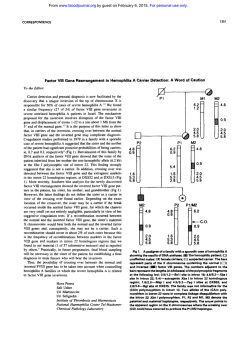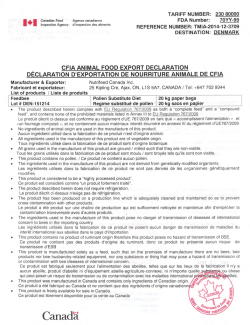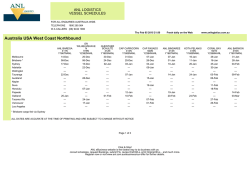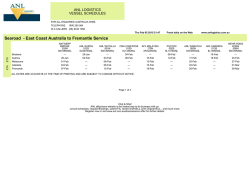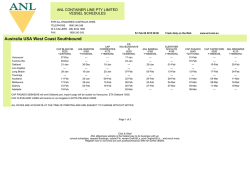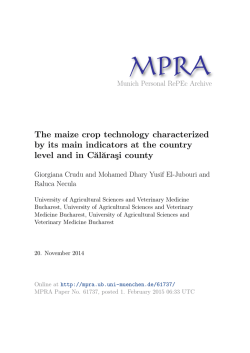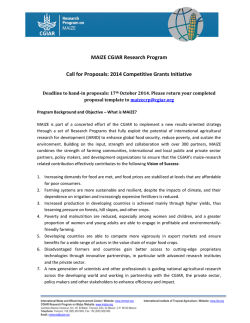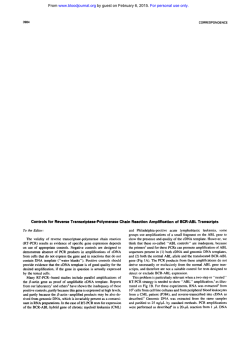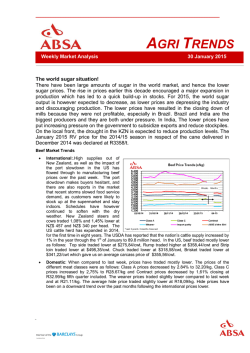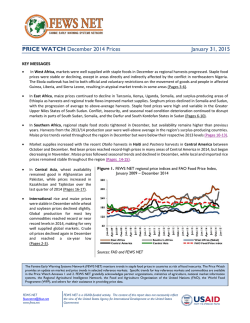
Cloning and Characterization of the Maize Anl Gene
The Plant Cell, Vol. 7, 75-84. January 1995 S 1995 American Society of Plant Physiologists Cloning and Characterization of the Maize Anl Gene Robert J. Bensen,' G u r m u k h S. Johal,a3'Virginia C. Crane,' John T. Tossberg,' Patrick S. Schnable,b Robert 6. Meeley,' a n d Steven P. Briggsav2 Pioneer Hi-Bred International, Inc., P.O. Box 1004, Johnston. lowa 50131 Department of Agronomy, lowa State University. Ames, lowa 50011 The Anther e a r l (Anl) gene product is involved in the synthesis of ent-kaurene, the first tetracyclic intermediate in the gibberellin (GA) biosynthetic pathway. Mutations causing the loss of A n í function result in a GA-responsive phenotype that includes reduced plant height, delayed maturity, and development of perfect flowers on normally pistillate ears. The anl::Mu2-891339 allele was recovered from a Mulator (Mu) F2 family. Using Mu elements as molecular probes, an Anl-containing restriction fragment was identified and cloned. The identity of the cloned gene as A n l was confirmed by using a reverse genetics screen for maize families that contain a Mu element inserted into the cloned gene and then by demonstrating that the insertion causes an a n l phenotype. The predicted amino acid sequence of the A n l cDNA shares homology with plant cyclases and contains a basic N-terminal sequence that may target the A n í gene product to the chloroplast. The sequence is consistent with the predicted subcellular localization of AN1 in the chloroplast and with its biochemical role in the cyclization of geranylgeranyl pyrophosphate, a 20-carbon isoprenoid, to ent-kaurene. The semidwarfed stature of a n l mutants i s in contrast with the more severely dwarfed stature of GA-responsive mutants at other loci in maize and may be caused by redundancy in this step of the GA biosynthetic pathway. DNA gel blot analysis indicated that A n l is a single-copy gene that lies entirely within the deletion of the anl-bz2-6923mutant. However, homozygous deletion mutants accumulated ent-kaurene t o 20Oh of the wild-type level, suggesting that the function of A n l i s supplemented by an additional activity. INTRODUCTION The morphological consequences of gibberellin (GA) deficiencies vary among plant genera but typically include reduced cell elongation and ,aberr,antfloral development (Reid, 1986). The phenotype of GA-responsive mutants of maize includes reduced plant stature due to shorter internode lengths, shorter broader leaves, anda reduced number of branches in the tassels. In addition, anthers develop on the pistillate ear, resulting in a perfect flower in the normally pistillate dista1 floret and a staminate flower in the normally aborted proximal floret of each spikelet on the ear (Emerson and Emerson. 1922). These phenotypes are illustrated in Figures 1A to 1D. GAs are synthesized from the 20-carbon isoprenoidgeranylgeranyl pyrophosphate(GGPP), beginning with the cyclization of GGPP to copalyl pyrophosphate (CPP) and then of CPP to enf-kaurene. This two-step process is,catalyzed by kaurene synthases A and B (previously kaurene synthetases A and 6). respectively (Duncan and West. 1981). In maize, and likely in most higher plants, ent-kaurene is oxidized stepwise to enf7\~hydroxykauren,oic,acid,which is converted to the first GA in the pathway, GAI2-aldehyde (Suzuki et al., 1992). This is then oxidized to an active GA by,o,neof thjee parallel pathways. . . I Current address: Department of Agronomy. University of Missouri. Columbia. MO 65211. To whom correspondence.shouldbe addressed. , . . , In maize, the major pathway appears to be the early 13hydroxylation pathway (Hedden et al., 1982): with GA, being the primary bioactive product (Phinney and Spray, 1982). The biosynthetic block in two of the GA-responsive mutants of maize, d7 and d5, has been assigned by measuring accumulation of endogenous GA-biosynthetic intermediates and by observing growth responses to and metabolic tates of applied intermediates(Hedden and Phinney, 1979; Phinney and Spray. 1982; Spray et al., 1984; Fujioka et al., 1988). The biosynthetic role of a third gene, Antherearl (Anl) is less well defined. Mutations in An7 result in a GA-responsive phenotype that is reversiblewith applied enf-kaurene(Katsumi, 1964), suggesting that the An7 gene product functions in ent-kaurene synthesis. Cloning and'characterizationof Anl may clarify its function. The Mufafor (Mu)transposable.elementsystem has been used to clone many genes based only upon the phenotype of a mutant allele (Walbot, 1992). One drawback of transposon tagging with Mu is that revertant alleles are rare. Therefore. confirming that a tagged gene has been isolated typically requires characterization of additional alleles. We have addressed this drawback by using a reverse genetics technology that permits the rapid recovery of new alleles containing Mu insertions. For Anl, this was accomplished by using a pair of polymerasechain reaction (PCR) primers, one from the terminal inverted repeat 76 The Plant Cell .^^ - _•». r*£ i Figure 1. Phenotypes of GA-Responsive Maize Plants. (A) Homozygous an1::Mu2-89!339 plant at maturity. Note the reduced internode lengths, foreshortened broad leaves, and unbranched tassel common to GA-deficient mutants of maize. (B) Ear of anl plant at silking. Anthers are present in both florets of each spikelet of the ear. (C) Ear spikelet of am plant during grain filling. Anthers are in the proximal (left) and distal (right) florets. Note the full development of anthers in both florets, with the distal floret anthers spatially restricted by the developing kernel. (D) Anthers on the ear of a mature an1 plant. of Mu and one from the putative An1 clone, to survey a collection of DNA samples from individual plants for those that produce a PCR product with homology to the cloned gene. Such products are a consequence of Mu element insertion into the cloned gene. Seeds from plants whose DNA yielded such PCR products were planted and found to segregate for GA-responsive dwarfs, confirming that the cloned gene is An1. when compared with wild-type siblings. Despite its similarity in final plant height, the mutant developed more slowly. In the example shown in Figure 2, this affect was manifest as a delayed pollen shed, which was on average a 200-heat unit delay or ~8 days. This observation indicates that time to maturity in maize is influenced more by the GA content of the plant than is vegetative development. RESULTS Partial Reversal of the Floral Morphogenic Program Delay of Maturity in GA-Deficient Mutants The an1-bz2-6923 deletion allele of an1, when homozygous, did not cause a reduction in mature plant height or leaf length All maize alleles of GA-responsive or GA-non responsive mutants share the phenotype of having anthers on the normally pistillate ear. Whereas pistil development in ears of GA-responsive mutants is normal, anther development is derepressed, with anthers developing in both florets of the ear. The result is perfect Cloning the Anl Gene from Maize flowers in the distal floret and staminate flowers in the proximal floret of each ear spikelet. Whereas the anthers of the distal floret are initially larger. the anthers in the proximal floret are eventually better developed (Figure 1C). The retardationof the distal anthers may be due to spatial constraints caused by the developing kernel. The proximal anthers produce mature pollen that accumulates starch and possessesa germ pore. Sexual whorl identity and development of tassel florets in these mutants are normal, with both florets developing fertile anthers, whereas pistillate structures fail to develop. The effect of these mutations in tassels appears to be limited to reducingbranching and causing a poor pollen shed due to failure of the glumes to open and the filaments to elongate. Role of GA in Gametophyte Competition We tested the competitiveness of an7 pollen against Anl pollen using heterozygous an7-bz2-6923 deletion mutant plants as the pollen source in a cross to homozygous an7-bz2-6923 deletion mutant plants. The Bronze2 (822) gene provided a kernel marker to score the results of the cross, with bronzed kernels arising from pollinationsby an7 and purple kernels from An7 pollen. Using homozygous anl-bz2-6923 as the female parent minimized the potential for the silks to serve as a source of GA for the elongating pollen tube. The GA content of the silks appeared to be significantly reduced in homozygousan7bz2-6923 plants because the silks were delayed in their emergente from the ear husks and reduced in their final length. However, without actually measuring GA levels in silks, it cannot be ruled out that they provided sufficient GA to negate this competition test. Twelve crosses yielded 623 purple and 650 bronze kernels (a x 2 value of 0.56 with a P value between 0.3 and 0.5).This result indicates that viable pollen ratios, germ 2507 1004 700 o 900 1100 GDUSHD o 1400 Figure 2. Role of GA in Maturity of Maize A comparison of heat units required to maturity for anl-bz2-6923 and its wild-type siblings is shown. The height of wild-type siblings and anl-bz2-6923mutants at maturity is plottedversus growing degree units to pollen shed (GDUSHD). Under the growth conditions for this experiment. GDUSHDs accumulate a t a rate of 20 to 25 per day. Thus. 200 GDUSHD is equal to 8 to 10 days. Each open square represents one wild-type sibling plant. and each closed square represents one an1-622-6923plant. 77 tube formation and extension, and fertilization of ovules are competitive between homozygous anl and An7 pollen. Cloning the An7 Gene A GA-responsive phenotype was observed to segregate as a simple recessive in an active Mu tine. The mutation was shown to be allelic with anl and has been designated as anl::Mu2897339. DNA gel blot analysis of genomic DNA from an7::Mu2897339 and its wild-type siblings identified a 5.4-kb restriction fragment that cosegregated with the mutation, as shown in Figure 3. This fragment was cloned into E. DNA. Restriction analysis of this clone identified fragments of flanking sequence DNA. A 2.6-kb Xbal flanking fragment was subcloned for use as a probe (g2.6Xba). DNA gel blot analysis, shown in Figure 4: of maize genomic DNA demonstrated that Anl is a singlecopy gene. Selection and Sequence Analysis of An7 cDNA Using g2.6Xba as a probe. a 2.8-kb cDNA clone was recovered from a maize cDNA library. This cDNA appears to represent full-length mRNA based on RNA gel blot analysis; the primary product is a homologous transcript of -2.8 kb, as shown in Figure 5. The cDNA contains an open reading frame of 2.5 kb or 823 amino acids, as illustrated in Figure 6. The predicted amino acid sequence shares significant homology with higher plant cyclase genes from mint (Colby et al., 1993).tobacco (Facchini and Chappell. 1992): and castor bean (Mau and West, 1994). The homology with the cyclases ranges from 20 to 25% identity and 45 to 53% similarity. The dicot cyclases use polyprenyl-pyrophosphates(PP-PPi) as substrates and contain a putative PP-PPi binding domain that includes the consensus sequence DDXXD. The predicted amino acid sequence of maize An7. shares homology with the dicot cyclases on the immediate N-terminal side of and within the PP-PPi binding domain. but it lacks the final D residue. as illustrated in Figure 7A. In the maize Anl gene product, beginning with the second X residue of the consensus sequence of the domain, there are 15 amino acids that share 67% identity and 93% similarity with the amino acid sequence of the tobacco cyclase and similar homologies with the other dicot cyclases. In the dicot cyclases, however, these 15 amino acids are not contiguous with the PP-PPi binding domain in the dicot cyclases but are found -200 amino acids distal from the consensus sequence, toward the N terminus. Thus, relative to the dicot consensus, the PP-PPi binding domain in the maize An7 gene is disrupted by a juxtaposition of this conserved 15-amino acid sequence. The An7 gene product contains a basic N terminus within which 12of 32 amino acids are arginine and 17 of 32 are identical to a rice aspartate aminotransferasesequence (D16340), as illustrated in Figure 78. The basic nature of the N terminus suggests that it functions in targeting the protein to the chloroplast (Keegstra et al., 1989). No putative ATP or GTP binding 78 The Plant Cell 1 2 3 4 5 6 7 8 9 1 0 1 1 1 2 1 3 -2.0 * Figure 3. DMA Gel Blot Analysis: Cosegregation of the an1::Mu2891339 Allele and Mu-Containing Restriction Fragments. Lanes 1 to 13 contain Sstl-restricted genomic DMA from 13 individual homozygous F2 dwarfed an1::Mu2-891339 siblings. The DNA gel blot was probed with an internal Mu1 DNA fragment. A 5.4-kb restriction fragment partially homologous to Mu1 and common to all ant individuals is identified with an arrow. Molecular length markers are shown at right in kilobases. site consensus sequence (A/G-[X4]-GK-S/T) is present in the predicted amino acid sequence of An1. This is consistent with An1 encoding a synthase rather than a synthetase and supports the in vitro assay results, which suggest that no ATP or GTP is required for kaurene synthase activity (Duncan and West, 1981). A comparison of cDNA and an1::Mu2-891339 genomic DNA sequences demonstrated that a Mu2 element is inserted within an exon and is 1.6 kb from the C terminus oi the transcript. analysis, and a homozygous an1::Mu2-891339 plant (lanes 4). A blot of the gel shown in Figure 8A was probed with a genespecific probe from the putative An1 clone. The results are illustrated in Figure 8B and confirm that the PCR products are homologous to the putative An1 clone. As expected, when using the Mu terminal inverted repeat primer paired with either the reverse or forward primer from the putative An1 clone, no products were formed from the wild-type plant DNA because no Mu elements were inserted in the putative Anl gene of this plant. Conversely, these same primer pairs yielded PCR products from homozygous an1::Mu2-891339 DNA and from heterozygous an1::Mu-110H10 and an1::Mu-T28E11 plants, demonstrating that each of these three plants has a Mu element insertion in the putative Anl gene. All four plants yielded a PCR product of ~1.2 kb using just the forward and reverse primer pair. This product was expected from the wild-type plant and from the heterozygous an1::Mu110H10 and an1::Mu-128E11 plants but not from homozygous an1::Mu2-891339. The primers were probably using the wild-type allele of the gene as the preferred template in the heterozygotes (F+R, lanes 2 and 3 of Figure 8A). The PCR product that was produced when using the forward and reverse primers on DNA from homozygous an1::Mu2-891339 plants was unexpected because both copies of the putative Anl gene have Mu element insertions. This PCR product may have resulted from the presence of revertant sectors (i.e., Mu excisions) or from synthesis that was facilitated by a looping out of the element. The sum of the sizes of the PCR products from the Mu primer paired with the forward and reverse primers was approximately equal 1 2 3 4 5 6 7 8 Confirmation of Clone Identity Independent Mo-induced an1 alleles were used to confirm the identity of the putative Anl clone. These independent alleles were obtained by a reverse genetics screen of a large collection of F, maize plants containing active Mu elements. The principle of the screen involves the pairing of a gene-specific primer with a Mu-specific primer to identify plants that contain Mu insertions in the target gene. A primer homologous to the terminal inverted repeat of Mu and two primers from the putative An1 gene were used in such a screen. Two F! plants that yielded a PCR product hybridizing with the Anl probe were identified. Shown in Figure 8A are the PCR products from DNA preparations of a homozygous wild-type control plant (lanes 1), the two heterozygous F, plants an1::Mu-110H10 (lanes 2) and an1::Mu-128E11 (lanes 3) that were selected for further Figure 4. DNA Gel Blot Analysis: Deletion Mutant an1-bz2-6923. A DNA gel blot of Sstl-digested genomic DNA of the deletion mutant (lanes 1,2,5, and 6), wild-type sibling DNA (lanes 3 and 7), and wheat DNA (lanes 4 and 8) was probed with a cDNA clone of An1. The amount of DNA applied to lanes 2 and 6 was twice that applied to the other lanes. Hybridization conditions for both blots were similar. Lanes 1 to 4 represent a high-stringency (65°C) wash, and lanes 5 to 8 represent a low-stringency (25°C) wash. Molecular length markers are shown between the blots in kilobases. Cloning the An1 Gene from Maize 7.54.42.41.4- Figure 5. RNA Gel Blot Analysis: Total RNA Probed with the Genomic An1 Subclone. Ten micrograms of total RNA, prepared from shoots of light-grown maize seedlings, was used for RNA gel blot analysis. The g2.6Xba genomic subclone of An1 was used to probe the blot. Molecular length markers are given at left in kilobases. to the size of the product from the forward and reverse primers for all three mutant plants (lanes 2 to 4 of Figure 8A). The differences in the sizes of the individual PCR products that each of the three plants produced resulted from differences in the position of the Mu insertion relative to the primers and confirmed their independent derivation. Seed produced by self-pollination of the heterozygous anT.:Mu-110H10 and an1::Mu-128E11 plants resulted in seedlings segregating for GA-responsive dwarfs. This demonstrated that both independently derived insertion alleles of the putative An1 clone resulted in a GA-responsive, an1 phenotype and confirmed that the cloned gene is Anl. Basis for Semidwarfed Nature of an1 Plants Unlike the other GA-responsive mutants of maize, an1 is typically semidwarfed. The measurable growth response of an1 plants to applied enf-kaurene suggests that it is deficient in the conversion of GGPP to enf-kaurene. Figure 4 shows a DNA gel blot of homozygous deletion mutant an1-bz2-6923 DNA (lanes 1 and 2), tall sibling DNA (lane 3), and wheat DNA (lane 4) that was probed with the full-length An1 cDNA and washed at high stringency. Hybridization to tall sibling DNA (indicated by the two arrows to the left of the figure) and to wheat DNA was detectable under these conditions, whereas no hybridization was detectable in lanes containing an1-bz26923 DNA. This indicates that the An1 gene lies within the deletion and that its transcript is not present in an1-bz2-6923 plants. This mutant should therefore not be able to synthesize enf-kaurene. However, as shown in Table 1, light-grown an1- 79 bz2-6923 seedlings accumulated enf-kaurene in vivo at a reduced but significant level (20%) compared with their wild-type siblings. This observation was confirmed after application of tetcyclacis, an inhibitor of enf-kaurene oxidation. Tetcyclacis treatment also resulted in a similar difference in enf-kaurene levels between anT.:Mu2-891339 and its tall siblings. The approximately 10-fold increase in enf-kaurene levels observed in the tall siblings of both an1 mutants reported in Table 1 was also observed in the commercial inbred line B73. The accumulation of enf-kaurene in the deletion mutant must have resulted from a nor\-An1 activity that supplements An1 production of enf-kaurene. When the stringency of the hybridization wash was lowered, hybridization to at least two an1-bz2-6923 DNA restriction fragments was detectable in lanes 5 and 6 of Figure 4 (shown by the arrows to the right). This indicates that partially homologous, non->4n7 sequences are present in maize. Based on these observations, the semidwarfed phenotype of an1 may have resulted from a partially homologous functionally equivalent gene. Such redundancy does not exist or is of little significance for maize d5 mutants, which are severe dwarfs. The d5 gene is thought to encode kaurene synthase B (Hedden and Phinney, 1979); its block of enf-kaurene synthesis appears to be nearly complete (Table 1). DISCUSSION Sequence Analysis The predicted gene product of An? shares sequence homology with higher plant cyclase genes, including 5-ep/-aristolochene synthase from tobacco (Facchini and Chappell, 1992), (-)-4Slimonene synthase from mint(Colbyetal., 1993), andcasbene synthase from castor bean (Mau and West, 1994). This is consistent with the role of the An1 gene product as an enzyme catalyzing the cyclization of GGPP to enf-kaurene. The dicot cyclase activities used the polyprenyl-pyrophosporylated compounds farnysyl, geranyl, and geranylgeranyl pyrophosphate, respectively, as substrates. The dicot cyclases are polypeptides of 50 to 60 kD that share 31 to 42% identity and 53 to 65% similarity with each other. They also share significant homology with the An1 gene product. Their homology with each other is evenly distributed throughout their entire sequence as is their homology with Ant However, minimal homology exists between the An1 gene product and the dicot cyclases in the N-terminal 150 to 250 amino acids of the An1 gene product. This is most likely the result of An1 encoding a larger polypeptide of ~83 kD with most of the nonhomologous coding sequence found at the 5' end of the transcript. The significance of the sequence homology remains unclear, except to suggest a cyclase function for the An1 gene product. The cloned higher plant cyclases act on monoterpenoids, sesquiterpenoids, and diterpenoids. Although their substrates differ, their proposed reaction mechanisms share the feature of an initial ionization of an allylic pyrophosphate (Hanson, The Plant Cell 80 -43 -42 17 18 77 78 137 138 197 198 257 258 317 318 377 1278 1337 1338 1397 1398 1457 1458 1517 1518 1577 1578 1637 1638 378 437 438 497 498 557 558 617 618 677 678 737 TCGTCGA~GTACGG~ACCCCGGCG~GCAGACCATATACG~CAGGGAAG~ V D F P Y G H P A L Q S I Y A N R E V W Y K D N C L D A F G V E P O D V L R S 1698 1757 1758 1817 1818 1877 1878 1937 1938 1997 1998 2057 2058 2117 2118 2177 2178 2237 2238 2297 2298 2357 2358 2417 2418 2477 2478 2537 K 738 797 AGCTGAAGCGGATCCCAAGGGACATGA~CACAGGGT~A~T~TCCTGCACAGCC L K R I P R D M M H R V P T S I L H S L 798 857 858 917 918 977 978 1037 1038 1097 1098 1157 1158 1217 1218 1697 CGTGGTACAAGCATAATTG~A~~GGAGTAGAACCA~GATG~AAGAT 2538 2597 2598 2657 1277 2658 Figure 6. Nucleotide and Predicted Amino Acid Sequences of An7. The nucleotide and predicted amino acid sequences of Anl are shown. The predicted amino acid sequence of the longest open reading frame is shown. The nucleotide sequence data reported here have been submitted to GenBank and assigned accession number L37750. 1972; Facchini and Chappell, 1992; Colby et al., 1993; Mau and West, 1994), resulting in the removal of the pyrophosphate moiety from the substrate as a part of their catalysis. A putative PP-PPi binding domain has been proposed to function in coordinating Mg2+or Mn2+cofactors via direct salt bridges to the metal ion that also complexes with the PPI group. The PP-PPi binding domain (1ILIV)XDDXXD is shared with enzymes such as farnysl pyrophosphate synthase from Escherichia coli, yeast, rat, and humans and GGPP synthase from Neurospora, Erwinia, and Rhodobacter; all of these enzymes use pyrophosphorylated isoprenoids as substrates (for summary, see Math et al., 1992). The An7 gene product lacks the final D residue of the PP-PPi binding domain consensus sequence. Instead, the An7 gene product has juxtaposed at this position a 15amino acid sequence that is found -200 amino acids away in the dicots. For these 15 amino acids, the predicted amino acid sequence of the An7 gene product is 67% identical and 93% similar to the dicots. The disruption of this binding do~ pyrophosphorylase function. This main may result in a l o s in would be consistent with the possibility thatAn7 encodes kaurene synthase A. Kaurene synthase A converts GGPP to CPP, which is a cyclization that occurs without the loss of the pyrophosphate moiety, whereas kaurene synthase B converts CPP to ent-kaurene, with the loss of the pyrophosphate (Shechter and West, 1969; Duncan and West, 1981). The N terminusof theAn7 gene product has characteristics expected of a choroplast targeting sequence (Keegstra et al., 1989), including a net positive charge (12 of 43 amino acids are basic; two are acidic). In addition, theAn7 N terminus also has a 53% identity with the N-terminal 27 amino acids of a rice aspartate aminotransferase clone (D16340). Aspartate aminotransferase has many isoforms, including some that are localized to the chloroplast (Wadsworth et al., 1993). The net positive charge and homology with the N terminus of the rice Cloning the An7 Gene from Maize clone suggest that the N terminus of An7 serves as a chloroplast-targeting sequence. Additional support for chloroplastic localization of ent-kaurene synthesis comes from the demonstration that cell-free assays of purified chloroplasts synthesize enf-kaurene (Simcox et al., 1975; Moore and Coolbaugh, 1976; Railton et al., 1984). Basis of Semidwarfed Stature of anl Plants The phenotype of GA-responsive mutants of maize includes reduced plant height, which is a characteristic common to GA-responsive mutants from a number of plant species, including Arabidopsis, tomato, rice, pea, and barley (Reid, 1986). The reduction in plant height is partially ameliorated in an7 mutants; they are typically semidwarfs. Despite their semidwarfed stature, anl mutants remain anther eared. Although no measurements of GA content have been made in this tissue, the phenotype suggests that either the normal arrest in anther development on the ear is more sensitive to GA content reductions than is shoot elongation or that GA levels are more severely reduced in the ear than in the shoot. Based on our observation of ent-kaurene accumulation in an7-bz2-6923, a deletion mutant devoid of the An7 genomic sequence, a redundancy for An7 function is predicted. This prediction is not limited to maize. A deletion mutant of Arabidopsis, gibberellin requiringl-3 (ga7-3) is also expected to be devoid of enf-kaurene (its seedlings respond to applied enf-kaurene) because its Gal coding region is deleted (Sun et al., 1992). However, ga7-3 plants convert GGPP to CPP and CPP to enrkaurene in cell-free extracts of siliques (R.J. Bensen, unpublished 81 data). Furthermore, in a manner similar to the an7 mutants of maize, there are a number of ga7 isolates that have variable reductions in plant height (R.J. Bensen, unpublished data). Role of GA in Floral Development Flowers, known as florets in maize, are paired in the ear. Each pair alises from bifurcation of a spikelet, with one floret proximal to the ear axis and the other distal. Development of staminate structures in the ear is aborted in both florets, as is development of the pistillate structure in the proximal floret. Thus, the pistil of the distal floret contains the only gamete found in the spikelet. The effect of reduced GA levels on floral development was to block the abortion of the stamens in both florets of the ear. This resulted in a staminate flower in the proximal floret and a mature perfect flower in the distal floret. Whorl identity in flowers, which is regulated by MADS boxcontaining homeotic genes, is not affected by the reduced GA levels found in GA-responsive mutants. The effects on floral development in GA-responsive mutants occur at a point after the floral whorls have initiated. The GA-responsive mutants of maize share the trait of having floral abortion patterns superimposed on normal whorl identities with pistillafe @i),silkless (sk), and some of the tassel seed (ts) types (notably tsl and ts2). The relationship between the mode of action of these floral development mutants is unclear. Double mutants of ts2 d7 and sk ts2 indicate that ts2 is additive to d7 and epistatic to sk (Jones, 1932, 1934; lrish et al., 1994). This suggests that fs2 acts to alter floral development by a pathway that is independent of the d7 pathway and is likely to be an interactive pathway for sk. A w 374-397 TOBACCO 2 4 0 - 2 5 1I 5 6-6 7 CASTOR 349-360/165-176 u S N V K D V D D T-------- A MA F R L L R L H G Y N V S I I I IIII IIIIIIII IIIIII IIIIIIIIIII II IIIIIIIIllIl I IIIIIIIIIIII IIIIIIIIIIIIIII S M I S I V D D T F D A / A L Q P R L L R Q H G P N I S L L I S L I D D T P D A / A A L I T V I D D I Y D V / I V F R V F R Q H G P K M S S L A P R L L R E H G P Q V A 3 4 6 - 3 5 1 1 1 6 1 - i7 2 B MAU 6-37 BL(;E 32-58 P Y P W Q S S R R R R R R R G R D G A P R Q P Q A R R V V E R A I I II IIIII IIII P L P R Q S Q R R R R R L P 0 R Q R------ IIIII fII - - -Q A R R A R V R A Figure 7. Amino Acid Sequence Comparisons. (A) Comparison of PP-PPi binding domains. The predicted amino acid sequences of maize An7, tobacco 5-epi-aristolochenesynthase, castor bean casbene synthase, and mint (-)-4S-limonene synthase at the PP-PPi binding domain are illustrated. The numbers below the species labels indicate the amino acid number in the sequence, counting the N terminus as 1. The maize sequence is contiguous with the dashed line representing a gap for best fit. The other sequences are not contiguous, with the breaks in their sequences illustrated with slashes. ldentity between sequences is indicated with a solid line; similarity is shown with a broken line. (6)Comparison of N-terminal sequences. The predicted amino acid sequences near the N terminus of maize An7 and rice aspartate amino transferase (D16340) are illustrated. Numbers, solid and broken lines, and the dashed line are as given in (A). 82 The Plant Cell Mu-t-R previously described (Johal and Briggs, 1992), using Duralose-UV membranes (Stratagene). A Mul probe was synthesized by random priming (Amersham Corporation) a gel-eluted internal 650-bp AvalBstEII Mul fragment isolated from pA/B5 (Chandler and Walbot, 1986). This internal Mu1 fragment shares regions of homology with MuZ and permits hybridization to both Mul and Mu2 sequences. Mu-t-F Cloning Protocol B 1 Mn-t-R 2 3 4 1 Mu-t-F 2 3 4 1 F-f R 2 3 tb 1.6 — 1.0 — 0.5 — The genomic DNA restriction fragment containing the Mu2 element of the anT.:Mu2-891339 allele was electroeluted after preparative agarose gel electrophoresis of Sstl-digested anT.:Mu2-891339 DNA, dialyzed, and concentrated by ethanol precipitation. Precipitated fragments were preannealed to Sstl-restricted arms of the bacteriophage vector X sep6llac5 (from R. Martienssen, Cold Spring Harbor Laboratory, Cold Spring Harbor, NY) and packaged using Gigapack Gold (Stratagene). This library was screened for Mu-containing phage, with the Sstl insert of a plaque-purified Mu-containing clone then transferred to the bacteriophage vector XZAPII (Stratagene). This insert and other clones used for probing or sequencing were all subcloned into pBluescript SK+ and maintained in SURE cells (Stratagene). cDNA Library Screening Figure 8. Confirmation of An1 Clone Identity. (A) Gene-specific PCR products. Gene-specific primers from the putative An1 clone (F, forward primer; R, reverse primer) were paired with a Mu terminal inverted repeat primer (Mu + R and Mu + F) or each other (F + R). PCR-positive plants were identified from a large screen and shown individually as heterozygotes in lanes 2 (an1::Mu-110H10) and lanes 3 (anT.:Mu-128E11). An inbred, nonmutated line (lanes 1) and homozygous an1::Mu2-891339 (lanes 4) served as negative and positive controls, respectively. (B) DNA gel blot of PCR products. A blot of the DNA gel shown in (A) was probed with a fragment of the putative An1 clone (homologous to the sequence between the forward and reverse primers) to confirm the PCR product identity. Moleculer length markers are indicated at left in kilobases. METHODS Plant Material A Mutator2 (Mu2)-tagged anther earl (an1) maize allele, an1::Mu2891339, was selected from lines with active Mu elements (lines were from D. Robertson, Iowa State University, Ames). Additional an1 alleles used in this study include an1-bz2-6923 (from M. Neuffer, University of Missouri, Columbia) and isolates an1::Mu-110H10 and an1::Mu-128E11 from the reverse genetics screen. an1-bz2-6923 is a deletion mutant. The extent of the deletion has not yet been defined, although /d(two map units proximal to An 1) and ad (two map units distal from Bronze2 (Bz2\) are unaffected by the deletion. DNA Gel Blot Analysis Total DNA was extracted from leaf tissue by the urea extraction method (Dellaporta et al., 1963). DNA gel blot analysis was performed as The maize cDNA library that served as a source for Am cDNA was prepared from whole kernels (30 days after pollination) of W22 (a gift from K. Cone, University of Missouri). Sequence data of a 2.8-kb An1 cDNA were generated by Loftstrand Laboratories, Ltd., Gaithersburg, MD. Table 1. enf-Kaurene Accumulation in Shoots of Light-Grown Maize Seedlings enf-Kaurene Content (pmol/gfwt) Plant an1-bz2-6923 Tall Dwarf an1::Mu2-891339 Tall Dwarf d5 Dwarf 673 Tall Leaf Length (mm) No Tetcyclacis 2nd Leaf Treatment (48 hr) 3rd Leaf 120 1330 83 33 209 61 54 710 216 ND 94 42 30 58 ND 1093 Seedlings were grown in continuous light for 6 days, at which time 20 nM tetcyclacis (an inhibitor of kaurene metabolism) was applied directly to the shoots. Forty-eight hours later, the shoots of treated and untreated plants were analyzed for enf-kaurene content, gfwt, grams fresh weight of tissue; ND, not detected. Tetcyclacis, an inhibitor of enf-kaurene oxidation, is manufactured by BASF, Ludwigshafen, Germany. Cloning the An7 Gene from Maize 83 RNA Preparation and Gel Blot Analysis Dellaporta, S.L., Wood, J.B., and Hicks, J.B. (1983). A plant DNA minipreparation: Version II. Plant MOI. Biol. Rep. 1, 19-22. Total RNA was prepared according to Chomczynski and Sacchi (1987). RNA gels were run, blotted, and probed as previously described (Johal and Briggs, 1992), using the g2.6Xba genomic flanking sequence subclone of An7 to generate a random-primed probe. Duncan, J.D., and West, C.A. (1981). Propertiesof kaurene synthetase from Marah macrocarpus endosperm: Evidence for the participationof separate but interacting enzymes. Plant Physiol. 68, 1128-1 134. Analysis of ent-Kaurene and Kaurene Synthase Activity Analysis of the in vivo levels of ent-kaurenein light-grown maize seedlings was performed by J.A.D. Zeevaart, Michigan State University, East Lansing, as previously described (Zeevaart and Gage, 1993). Polymerase Chain Reaction Analysis of Mu-Tagged A n l Alleles A large population of Mu-containing F1 maize families (24,000 individuals) was tested by using polymerasechain reaction (PCR) to detect the presence of Mo insertional alleles in the Anl gene. Primers specific for the putative Anl clone were chosen from both sides of the Mu insertion in the anl::Mu-897339 allele. A forward primer, 5’-GTGTGGAAACCGAGTCCGAAATTGCGAA-3; and a reverse primer, 5’-TAGCCCAGCAAATCCCATCTTCAGTCCA-3;were 788 and 404 bases from the Mu2 insertion, respectively. These primers generated wild-type amplificationproducts of 4 2 0 0 bp. The Mu primer 5’-CCCTGAGCTCTTCGTC(CT)ATAATGGCAATTATCTC-3’ is partiallyhomologousto the dista1 portion of the terminal inverted repeat common to all functional Mu elements. F1individualscontaining insertions in the putative An7 gene were identified by their productionof PCR products with homology to the putativeA n l clone using either the forward or reverse primers paired with the Mu-specific primer. Fz seed from plants producing PCR products were then planted in the greenhouse and scored for a gibberellin-responsivedwarf phenotype. ACKNOWLEDGMENTS We thank Jan A.D. Zeevaart for performingthe analysis of ent-kaurene levels reported in this article. Received September 28, 1994; accepted November 23, 1994. Emerson, R.A., and Emerson, S.E. (1922). Genetic interrelations of two andromonecious types of maize. Genetics 7, 203-227. Facchini, P., and Chappell, J. (1992). Gene family for an elicitorinduced sesquiterpene cyclase in tobacco. Proc. Natl. Acad. Sci. USA 89, 11088-11092. Fujioka, S., Yamane, H., Spray, C.R., Gaskin, P., MacMillan, J., Phinney, B.O., and Takahashi, N. (1988). Qualitative and quantitative analyses of gibberellins in vegetative shoots of normal, dwarf-7, dwarf-2, dwarf-3, and dwarf-5 seedlings of Zea mays L. Plant Physiol. 88, 1367-1372. Hanson, J.R. (1972). The bicyclic terpenoids. In Progress in Phytochemistry,Vol. 3, L. Reinhold, and Y. Liwschitz, eds(New York: John Wiley & Sons), pp. 231-234. Hedden, P., and Phlnney, 6.0. (1979). Comparison of ent-kaureneand ent-isokaurenesynthesis in cell-freesystems from etiolated shoots of normal and dwarf-5 maize seedlings. Phytochemistry 18, 1475-1479. Hedden, P., Phinney, B.O., Heupel, R., Fujii, D., Cohen, H., Gaskin, P., MacMillan, J., and Graebe, J.E. (1982). Hormonesof young tassels of Zea mays. Phytochemistry 21, 391-393. Irish, E.E., Langdale, J.A., and Nelson, T.M. (1994). lnteractions between tasselseedgenesand other sex determining genes in maize. Dev. Genet. 15, 155-171. Johal, G.S., and Briggs, S.P. (1992). Reductase activity encoded by the HM1disease resistance gene in maize. Science 258,985-987. Jones, D.F. (1932). The interaction of specific genes determiningsex in dioecious maize. Proc. Sixth Int. Congress Genet. 2, 104-107. Jones, D.F. (1934). Unisexual rnaize plants and their bearing on sex differentiationin other plants and anirnals. Genetics 19, 552-567. Katsumi, M. (1964). Gibberellin-likeActivities of Certain Auxins and Diterpenes. PhD Dissertation(Los Angeles: Universityof California). Keegstra, K., Olsen, L.J., and Theg, S.M. (1989).Chloroplastic precursors and their transport across the envelope membranes. Annu. Rev. Plant Physiol. Plant MOI. Biol. 40, 417-501. Math, S.K, Hearst, J.E., and Poulter, C.D. (1992). The crtE gene in Erwinia herbicola encodes geranylgeranyl diphosphate synthase. Proc. Natl. Acad. Sci. USA 89, 6761-6764. Mau, C.J.D., and West, C.A. (1994). Cloning of casbene synthase cDNA: Evidence for conserved structural features among terpenoid cyclases in plants. Proc. Natl. Acad. Sci. USA 91, 8497-8501. REFERENCES Moore, T.C., and Coolbaugh, R.C. (1976). Conversion of geranylgeranyl pyrophosphateto ent-kaurene in enzyme extracts of sonicated chloroplasts. Phytochemistry 15, 1241-1 247. Chandler, V.L., and Walbot, V. (1986). DNA modificationof a maize transposable element correlates with a loss of activity. Proc. Natl. Acad. Sci. USA 83, 1767-1771. Phinney, B.O., and Spray, C.R. (1982). Biochemicalgenetics and the gibberellin biosyntheticpathway in Zea mays L. In Plant Growth Substances 1982, P.F. Waring, ed (London: Academic Press), pp. 101-110. Chomczynski, P., and Sacchi, N. (1987). Single step method of RNA isolation by acid guanidinium thiocyanate-phenol-chloroform extraction. Anal. Biochem. 162, 156-159. Railton, I.D., Fellows, B., and West, C.A. (1984). ent-Kaurene synthesis in chloroplasts from higher plants. Phytochemietry 23, 1261-1267. Colby, S.M., Alonso, W.R., Katahira, E.J., McGarvey, D.J., and Croteau, R. (1993). 4s-Limonene synthase from the oil glands of spearmint (Mentha spicata). J. Biol. Chem. 268, 23016-23024. Reid, J.B. (1986). Gibberellin mutants. In A Genetic Approach to Plant Biochemistry, A.D. Blonstein and P.J. King, eds (Berlin: SpringerVerlag), pp. 1-34. 84 The Plant Cell Shechter, I.,and West, C.A. (1969). Biosynthesis of gibberellins. IV. Biosynthesis of cyclic diterpenes from trans-geranylgeranyl pyrophosphate. J. Biol. Chem. 244, 3200-3209. Simcox, P.D., Dennis, D.T., and West, C.A. (1975). Kaurene synthetase from plastids of developing plant tissues. Biochem. Biophys. Res. Commun. 66, 166-172. Spray, C., Phinney, B.O., Gaskin, P., Gilmour, S.J., and MacMillan, J. (1984). lnternode length in Zea mays L. The dwarf-7 mutation controls the 3P-hydroxylationof gibberellinAzoto gibberellin A,. Planta 160, 464-468. Sun, T.-p., Goodman, H.M., and Ausubel, F.M. (1992). Cloning the ArabidopsisGA7 locus by genomic subtraction. Plant Cell4,119-128. Suzuki, Y., Yamane, H., Spray, C.R., Gaskin, P., MacMillan, J., and Phinney, B.O. (1992). Metabolism of ent-kaurene to gibberellinA,*aldehyde in young shoots of normal maize. Plant Physiol. 98, 602-610. Wadsworth, G.J., Marmaras, S.M., and Matthews, B.J. (1993). Isolation and characterizationof a soybean cDNA encoding the plastid form of aspartate aminotransferase. Plant MOI.Biol. 21, 993-1009. Walbot, V. (1992). Strategies for mutagenesis and gene cloning using transposon tagging and T-DNA insertionalmutagenesis.Annu. Rev. Plant Physiol. Plant MOI. Biol. 43, 49-82. Zeevaart, J.A.D., and Gage, D.A. (1993). ent-Kaurene biosynthesis is enhanced by long photoperiods in the long-day plants Spinacia oleracea L. and Agrostemma githago L. Plant Physiol. 101, 25-29. Cloning and Characterization of the Maize An1 Gene R. J. Bensen, G. S. Johal, V. C. Crane, J. T. Tossberg, P. S. Schnable, R. B. Meeley and S. P. Briggs Plant Cell 1995;7;75-84 DOI 10.1105/tpc.7.1.75 This information is current as of July 15, 2011 Permissions https://www.copyright.com/ccc/openurl.do?sid=pd_hw1532298X&issn=1532298X&WT.mc_id=pd_hw1532298 X eTOCs Sign up for eTOCs at: http://www.plantcell.org/cgi/alerts/ctmain CiteTrack Alerts Sign up for CiteTrack Alerts at: http://www.plantcell.org/cgi/alerts/ctmain Subscription Information Subscription Information for The Plant Cell and Plant Physiology is available at: http://www.aspb.org/publications/subscriptions.cfm © American Society of Plant Biologists ADVANCING THE SCIENCE OF PLANT BIOLOGY
© Copyright 2025
